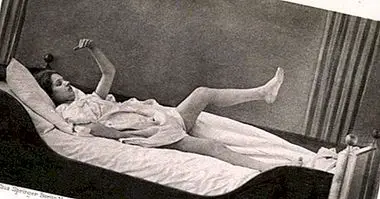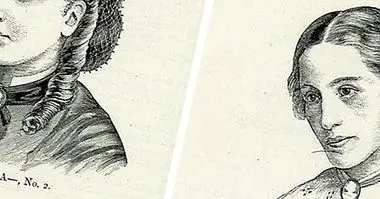Mystical or messianic delirium: symptoms, causes and treatment
Each and every one of us is unique and unrepeatable, and we have very different experiences and perceptions of the world and reality. In their majority they are interpretations that allow us to give meaning to what we live in a way that allows us to survive and adapt to the environment that surrounds us.
But sometimes there are alterations in the content of the thought that they make us interpret reality in a concrete way that is maladaptive and even harmful to oneself or to the environment, preventing our correct adaptation and biasing our vision in such a way that we make false judgments about the world. It is what happens with delusions.
Within delusions we can find different types, differentiated by the aspect or theme to which they refer. One of them links states of psychotic sensory alterations to spiritual beliefs, making us consider for example a being with a divine mission or even a messiah. We are talking about the mystical or messianic delirium .
- Related article: "Delusions: what they are, types and differences with hallucinations"
What is mystical delirium?
We understand mystical delirium as an alteration of the content of thought, the product of an anomalous interpretation of reality, of a religious-spiritual theme.
As delirium that is, it is a judgment or unchangeable and fixed idea that persists with great intensity despite the existence of evidence against, which usually generates a high level of concern or anxiety in the sufferer (or prevents the person from functioning usual) and that is at least very unlikely, having also a complete lack of social or cultural support for such an idea . It is often the product of the interpretation of an altered perception (like a hallucination), and it usually entails a certain rupture with reality.
In the case at hand, the delirium in question It has a content linked to spirituality and religiosity . An interpretation is made of the world, of the self and of others only on the basis of faith, seeing in everything that happens a confirmation of their beliefs and of the consideration of their role in the world.
They tend to have a consideration that the majority of acts carried out are sin and seeking to atone for their faults or those of the rest, in some cases even in a violent manner. It is not strange also that there are ideas of self-reference or even of greatness, considering the subject a superior entity, a divine envoy or even a deity.
Difference between religious belief and mystical delirium
For a person without religious beliefs, it can be relatively simple to attribute to people who do have this kind of delirium, given that religious beliefs per se tend to be modifiable and self-explanatory (Although most people consider these beliefs moldable and interpretable, others present them with fixity). But this is not the case, just as having a good level of self-esteem does not imply a delusion of greatness: we are simply facing a psychotic exacerbation of beliefs that were already basic.
In the mystical delirium is required the existence of revelation and mission, lived with ecstasy by the person who suffers it, in addition to the feeling of having a clear knowledge of the truth through this revelation. The abandonment of the lifestyle is also frequent carried until then and the total abnegation towards which they consider their mission . All this separates the mystical delirium from the normative religious-spiritual belief, in which there is no confusion followed by the idea of the meaning of the hallucinatory experience.
Causes of this delirium
The mystical delirium, as can be seen, has a strong religious and cultural influence as one of its main bases. However, the causes of the appearance of this delirium do not depend only on this factor, but there are multiple factors that contribute to its genesis. The delirium is perceived as a rational explanation by the subject , often serving to justify the existence of a hallucinatory experience that disturbs them.
Religiosity itself is a relevant factor but not necessarily determinant (there are controversies according to the study on whether its role is fundamental or a variable), although the specific religious beliefs of a person with this type of delirium usually determine the type of content of delirium. For example, in the Christian religion the delusions related to guilt tend to abound more, while in Judaism there is usually greater nocturnal hallucinatory experience associated with the connection of night with spirits .
Of course, many people with this type of problem do not have any specific religious beliefs, so that not all will have an effect. Other relevant factors are the level and type of education of the person and their marital status.
Likewise, the existence of this type of mystical delusions has been associated mainly to the presence of drug, food or drug intoxication, some medical or psychiatric diseases (including especially psychotic disorders such as schizophrenia), acute or chronic pain (interpretable). as a signal), or dementias. It is usually typical of people suffering from what Emil Kraepelin called paraphrenia, a chronic psychotic disorder in which delusions are relatively fanciful and in that except in the subject matter in question, people do not present great alterations.
Treatment of this type of delusions
The treatment of a delirium, regardless of its type, is complex and relatively slow. And we all tend to keep our beliefs more or less firm. This makes delusional experiences, which for those who have them better represent reality than others, are tried to perpetuate and direct modification attempts are directly rejected. Likewise interpretive biases of the phenomena that occur they make the subject reinforce his delusional ideation.
In all cases in the first place it is necessary to stabilize the patient if we are facing a psychotic disorder or to fight the infectious or toxic agent if we are facing an infection or intoxication of some kind. Once the psychological process has begun, it is first necessary to overcome the attitude of vigilance and aversion of the patient towards the therapist and gain their trust, without making a direct confrontation with their delusional beliefs. It seeks to promote the therapeutic relationship and achieve access little by little and as confidence grows in the core of ideation.
It is proposed that the patient go slowly introspection and visualizing what has led him to think in such a way. Generate an increase in communication and little by little adjusting thought processes towards a more adaptive reality scheme.
The type of environment that the patient has may also have a relevant role in their treatment, because it is possible that in the beginning the symptomatology is not considered aversive until after a long time. This increases the risk of chronicity and consolidation of delirium. In this sense, something of psychoeducation to the environment concerning the problem that the subject presents (always respecting the religious beliefs that they have), could be beneficial both for this and for the patient.
Bibliographic references:
- Bastidas, M. and Alberto, C. (2004). Validity of the mystical delirium in contemporary semiology. Colombian Journal of Psychiatry, vol. XXXIII (2): 172-181. Colombian Association of Psychiatry. Bogotá, D.C., Colombia.
- Rolling, D.E. and Fuentes, P. (2013). Mystical-religious delusions: historical journey, current validity and cultural implications in its genesis. Clepios 62. Journal of Professionals in Mental Health Training.



















